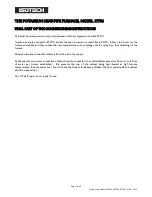
Page 31 of 40
Dual Furnace Models M17705, N17706 & 17707 Iss.09 – 12/14
THERMOMETRIC FIXED POINTS; A TUTORIAL
The International Temperature Scale, the scale most used in science and industry, is based on a series of fixed point
temperatures. Fixed points involve two-phase or three-phase equilibria of, ideally, pure materials to which constant
temperature values have been assigned by primary thermometry. Defining fixed points are chosen to be as few in
number as is consistent with the need to establish satisfactory interpolation procedures.
There are secondary reference points which, also, are two-phase or three-phase equilibria of very pure materials,
whose temperature values have been established by measurements made with interpolation instruments calibrated
at the defining fixed points. Secondary reference points are useful for the calibration of thermometers having total
ranges shorter than the interpolation ranges of the Scale. Generally, secondary points are admitted to the Scale only
if the material is generally available in high purity and if sufficient reproducibility of the equilibrium temperature has
been confirmed by measurements made independently by a considerable number of investigators. An average value
(weighted according to individual uncertainties) is then used as the ITS temperature value.
Two-phase equilibria may be solid-liquid, liquid-vapour, or solid-vapour. From the Phase Rule of Gibbs:
P + F = C + 2
P is an integer equal to the number of phases present, C is the number of components present - for a pure material
C = 1 - and F is an integer representing the number of degrees of freedom. It is evident that the temperatures of
two-phase equilibria are pressure-dependent (one degree of freedom only) whereas equilibria in which all three
phases are present (triple points) are characterised by unique values of temperature and pressure (zero degrees of
freedom).
A necessary condition to establish a triple point is to contain the appropriate material in a sealed enclosure from
which all other materials, including air, have been evacuated, leaving a space to be filled by the vapour phase at a
pressure appropriate to the temperature. When the three-phase (solid, liquid, vapour) condition has been
established, these parameters will settle to their unique triple-point values.
The defining fixed points above 0°C are liquid-solid equilibria of high-purity metals. Pressure-dependence is small and
thermal capacity and thermal conductivity are relatively high. Metals are generally available with a purity of 99.999%
("five-nines") or 99.9999% ("six-nines").
Figure 2 shows the design of a cell for realising the liquid-solid equilibrium of pure metal. The metal is contained in a
crucible of purified graphite, with a graphite cover and a graphite re-entrant sleeve. The crucible is enclosed in an
envelope of fused quartz, which extends into the sleeve interior to form the thermometer well. The cell is charged
with a pure metal, purged and filled with sufficient argon (or another inert gas) to give a pressure of 101kPa (1
standard atmosphere) at the freezing temperature and then sealed. Thus it is at once protected from contamination
and supplied with an inert atmosphere at the required pressure at the equilibrium temperature. A correction for the
effect of change in ambient pressure on freezing point need not be made. Sealed cells of this type have shown no
measurable change after 15 years of use.
In general, sealed fixed-point cells are used in vertical-tube furnaces which provide good temperature control and
sufficient cell immersion to make axial temperature gradients, in the measurement zone, negligible. With the cell in
the furnace, the controller is first set about 5°C above the anticipated value corresponding to the melting
temperature of the metal in the cell. The onset of melting is indicated by a cessation of temperature rise because of
the latent heat required to produce the phase change. This melt plateau can last for a considerable period of time.
When melting is complete, the cell temperature will rise to the furnace temperature.





































